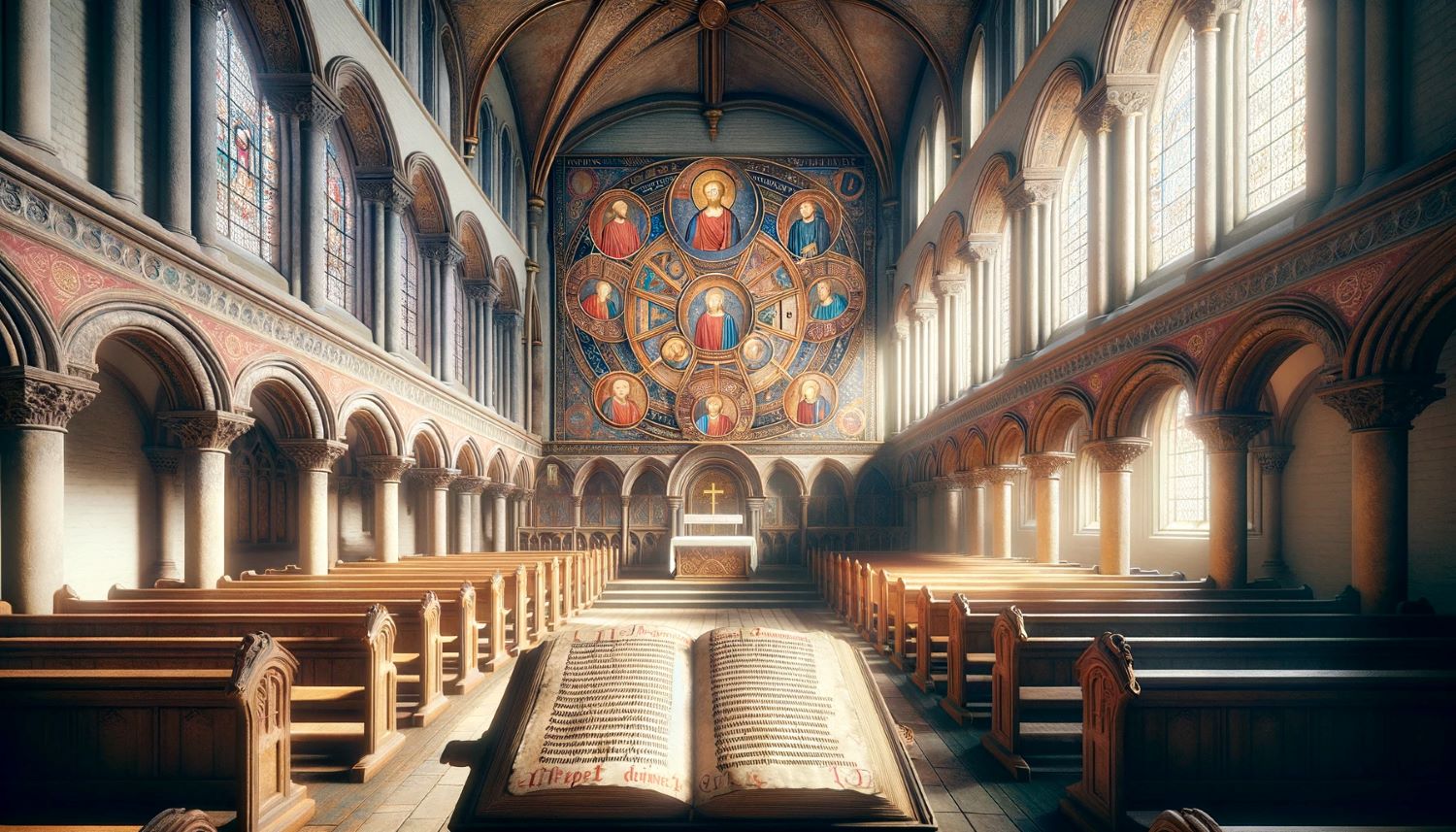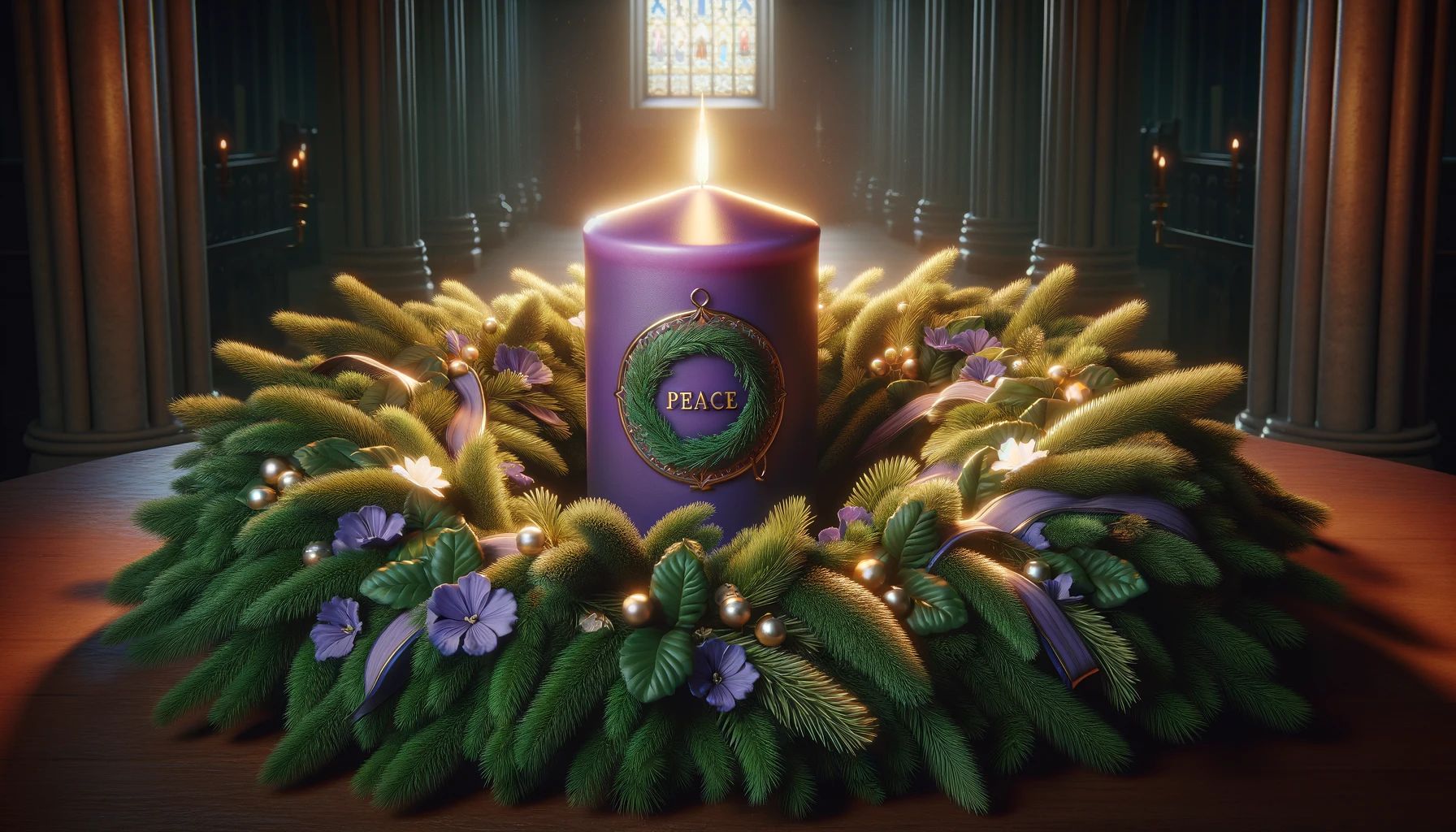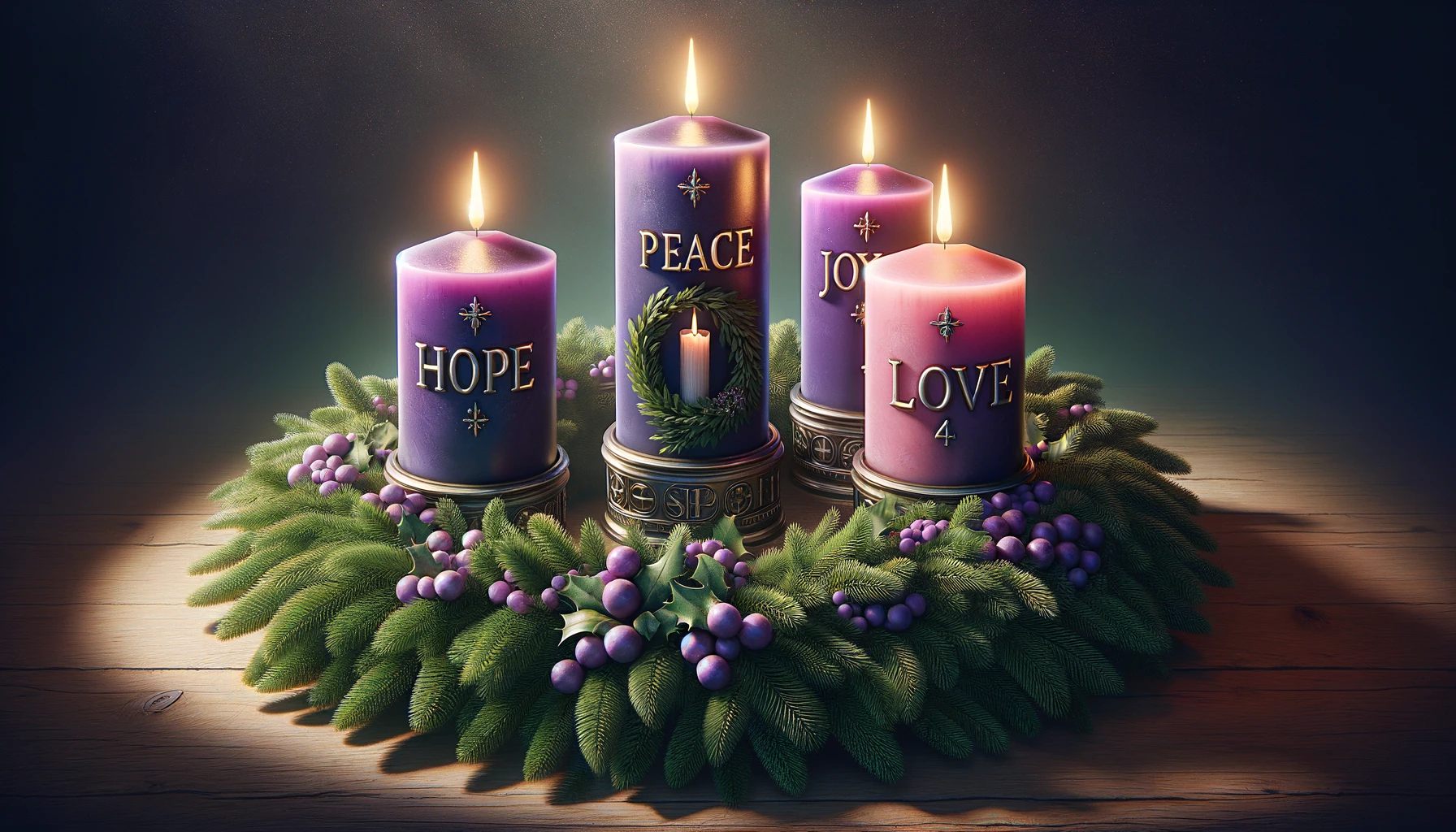Home>Special Themes>What Does Advent Mean In Catholic Church


Special Themes
What Does Advent Mean In Catholic Church
Published: February 13, 2024
Ericka Andersen, an editor at Christian.net, expertly merges digital strategy with content creation, focusing on faith and societal issues. Her communication skills enhance the platform's engaging narratives, fostering meaningful dialogue on belief's impact on society.
Discover the significance of Advent in the Catholic Church and its special themes. Explore the meaning and traditions of this sacred season.
(Many of the links in this article redirect to a specific reviewed product. Your purchase of these products through affiliate links helps to generate commission for Christian.net, at no extra cost. Learn more)
Table of Contents
Introduction
Advent, a word derived from the Latin "adventus," meaning "coming" or "arrival," holds a significant place in the liturgical calendar of the Catholic Church. This sacred season serves as a time of spiritual preparation and joyful anticipation for the celebration of the birth of Jesus Christ at Christmas. It is a period of reflection, hope, and expectation, inviting believers to delve into the profound meaning of Christ's incarnation and to prepare their hearts to welcome Him anew into their lives.
During Advent, the faithful are called to embrace a spirit of contemplation and to focus on the dual nature of Christ's coming – both as a historical event over two millennia ago and as a future promise of His return in glory. This season encourages believers to engage in prayer, penance, and acts of charity, fostering a sense of spiritual readiness for the coming of the Lord.
As we embark on this journey through the rich tapestry of Advent, we will explore its deep-rooted significance, delve into its historical origins within the Catholic Church, unravel the symbols and traditions associated with this season, and uncover the profound importance of Advent in the context of Catholicism. Furthermore, we will examine the various practices and observances that mark this sacred time, shedding light on the ways in which the faithful engage with the Advent season in their spiritual lives.
Join us as we embark on a captivating exploration of Advent, delving into its essence and uncovering the timeless wisdom it imparts to the faithful. Let us traverse the path of anticipation and preparation, embracing the profound meaning of Christ's coming and the transformative power it holds for believers around the world.
The Meaning of Advent
Advent, in the context of the Catholic Church, encapsulates a profound sense of anticipation and spiritual preparation for the celebration of the birth of Jesus Christ. It marks the beginning of the liturgical year and serves as a period of joyful expectation, inviting believers to reflect on the significance of Christ's incarnation and to prepare their hearts to welcome Him anew into their lives.
At its core, Advent embodies a dual sense of waiting – looking back to the historical event of Christ's birth in Bethlehem and looking forward to His promised return in glory. This season calls upon the faithful to embrace a spirit of hope and longing, fostering a deep sense of spiritual readiness for the coming of the Lord.
The four weeks of Advent are symbolized by the lighting of the Advent wreath, with each candle representing a different aspect of the spiritual journey – hope, peace, joy, and love. As believers progress through this sacred season, they are encouraged to engage in prayer, reflection, and acts of charity, cultivating a sense of inner renewal and spiritual awakening.
Moreover, Advent serves as a poignant reminder of the humble circumstances surrounding the birth of Jesus, emphasizing the virtues of humility, simplicity, and faith. It beckons believers to emulate the example of Mary and Joseph, who awaited the arrival of the Messiah with unwavering trust and obedience to the divine will.
In essence, Advent encapsulates the essence of faith, beckoning believers to embrace the timeless message of hope, love, and redemption heralded by the birth of Christ. It serves as a spiritual journey, guiding the faithful towards a deeper understanding of the profound significance of Christ's coming and the transformative power it holds for those who open their hearts to receive Him.
As we immerse ourselves in the rich tapestry of Advent, we are reminded of the enduring message of salvation and the promise of Emmanuel – "God with us." This sacred season calls upon believers to prepare the way for the Lord, to kindle the flame of faith within their hearts, and to rejoice in the wondrous gift of Christ's presence in their lives.
In the next section, we will delve into the historical origins of Advent within the Catholic Church, tracing its evolution and enduring significance throughout the centuries. Join us as we embark on a captivating journey through the annals of history, unraveling the timeless traditions and symbols that define this sacred season.
The History of Advent in the Catholic Church
The history of Advent in the Catholic Church traces its origins to the early centuries of Christianity. The exact emergence of Advent as a distinct liturgical season is not precisely documented, but its roots can be found in the ancient practices of the early Christian communities.
During the early centuries, the Church Fathers emphasized the importance of spiritual preparation and penitential practices leading up to the celebration of the Nativity of Christ. This period of preparation varied in duration and intensity, with fasting, prayer, and almsgiving forming integral aspects of the spiritual discipline observed by believers.
The Council of Tours in 567 is credited with formalizing the celebration of Advent, establishing a period of fasting and abstinence in preparation for the feast of Christmas. Over time, the observance of Advent evolved, with the duration of the season fluctuating between four and six weeks in different regions of the Christian world.
The liturgical reforms of the Second Vatican Council in the 1960s brought about significant changes to the observance of Advent within the Catholic Church. The focus shifted towards emphasizing the dual themes of Christ's coming – His historical birth in Bethlehem and His promised return in glory. The liturgical color of Advent, traditionally purple, was retained to symbolize penance and preparation, while the third Sunday of Advent, Gaudete Sunday, introduced a note of joyful anticipation with the use of rose-colored vestments.
In contemporary times, the observance of Advent continues to hold a central place in the liturgical calendar of the Catholic Church. The faithful engage in a period of spiritual reflection, anticipation, and joyful expectation, immersing themselves in the timeless traditions and rituals that define this sacred season.
As we delve into the historical tapestry of Advent, we gain a deeper appreciation for its enduring significance within the Catholic Church. The evolution of Advent as a season of spiritual preparation and joyful anticipation reflects the timeless commitment of believers to prepare their hearts to welcome the coming of Christ – a tradition that continues to resonate with the faithful across the globe.
In the next section, we will explore the symbols and traditions of Advent, unraveling the rich tapestry of imagery and practices that define this sacred season. Join us as we embark on a captivating journey through the timeless symbols that herald the advent of Christ's birth.
The Symbols and Traditions of Advent
The symbols and traditions of Advent are deeply rooted in rich imagery and profound spiritual significance, encapsulating the essence of joyful anticipation and spiritual preparation for the celebration of Christ's birth. These timeless symbols serve as poignant reminders of the profound meaning of Advent and the transformative power it holds for believers.
The Advent Wreath
Central to the observance of Advent is the iconic Advent wreath, a circular arrangement of evergreen branches adorned with four candles, typically three purple and one rose. Each candle represents a different aspect of the spiritual journey – hope, peace, joy, and love. The lighting of these candles, one for each week of Advent, symbolizes the progressive illumination of the world by the light of Christ, culminating in the lighting of the Christ candle on Christmas Eve.
Read more: What Does Advent Mean In The Bible
The Colors of Advent
The liturgical colors of Advent, traditionally purple, symbolize penance, preparation, and royalty, reflecting the dual themes of Christ's coming – His historical birth and His promised return in glory. The use of rose-colored vestments on Gaudete Sunday, the third Sunday of Advent, signifies a moment of joyful anticipation amidst the penitential season, heralding the imminent arrival of the Lord.
The Advent Calendar
The Advent calendar, a cherished tradition in many households, serves as a visual countdown to Christmas, marking each day of Advent with a small door or compartment containing a surprise or a religious image. This beloved tradition not only builds excitement for the upcoming celebration but also provides an opportunity for families to engage in daily reflections and prayers, fostering a sense of spiritual preparation and anticipation.
The Jesse Tree
Another cherished tradition is the Jesse Tree, which traces its roots to the Old Testament lineage of Jesus Christ. This symbolic tree is adorned with ornaments representing key figures and events from salvation history, leading up to the birth of Christ. Each ornament serves as a visual reminder of the unfolding narrative of God's redemptive plan, inviting believers to reflect on the profound significance of Christ's incarnation within the broader context of salvation history.
The O Antiphons
The O Antiphons, a series of seven ancient liturgical texts dating back to the early centuries of Christianity, are traditionally recited or sung during the final days of Advent. These antiphons, each beginning with the exclamation "O," express the longing of the human heart for the coming of the Messiah and the fulfillment of God's promises. They serve as a poignant expression of the collective yearning for the arrival of Christ, infusing the season with a sense of profound anticipation and hope.
In essence, the symbols and traditions of Advent form a tapestry of rich imagery and profound spiritual significance, inviting believers to embark on a journey of joyful anticipation and spiritual preparation. These timeless symbols serve as poignant reminders of the enduring message of hope, love, and redemption heralded by the birth of Christ, guiding the faithful towards a deeper understanding of the profound significance of Advent and the transformative power it holds for those who open their hearts to receive Him.
The Importance of Advent in Catholicism
The significance of Advent in Catholicism extends far beyond the anticipation of the Christmas celebration. It serves as a profound period of spiritual preparation, inviting believers to delve into the deeper meaning of Christ's incarnation and to cultivate a sense of joyful expectation for His coming. This sacred season holds immense importance within the fabric of Catholic tradition, embodying timeless virtues and theological truths that resonate with the faithful across generations.
At its core, Advent embodies the essence of hope, love, and redemption, encapsulating the anticipation of Christ's birth and the promise of His return in glory. It serves as a poignant reminder of the enduring message of salvation and the transformative power of Christ's presence in the lives of believers. Through the observance of Advent, Catholics are called to embrace a spirit of contemplation and renewal, fostering a sense of spiritual readiness for the coming of the Lord.
Moreover, Advent underscores the virtues of patience, humility, and faith, inviting believers to emulate the example of Mary and Joseph, who awaited the arrival of the Messiah with unwavering trust and obedience to the divine will. This season serves as a spiritual journey, guiding the faithful towards a deeper understanding of the profound significance of Christ's coming and the transformative power it holds for those who open their hearts to receive Him.
In the liturgical calendar of the Catholic Church, Advent marks the beginning of the new year, symbolizing a fresh start and a renewed sense of spiritual purpose. It provides a structured framework for believers to engage in prayer, reflection, and acts of charity, fostering a spirit of inner renewal and spiritual awakening. The observance of Advent offers a sacred space for believers to pause amidst the busyness of daily life, to reflect on the timeless truths of the Christian faith, and to prepare their hearts to welcome the coming of Christ with joy and reverence.
Furthermore, the importance of Advent in Catholicism is underscored by the enduring traditions and rituals that define this sacred season. From the lighting of the Advent wreath to the recitation of the O Antiphons, each practice serves as a poignant expression of the collective yearning for the arrival of Christ, infusing the season with a sense of profound anticipation and hope. These timeless traditions not only connect believers to the rich heritage of their faith but also provide a framework for spiritual growth and contemplation.
In essence, the importance of Advent in Catholicism lies in its ability to foster a deep sense of spiritual preparation, anticipation, and joyful expectation for the coming of Christ. It serves as a sacred season that invites believers to immerse themselves in the timeless truths of the Christian faith, to reflect on the enduring message of hope and redemption, and to prepare their hearts to welcome the birth of Jesus with renewed faith and reverence. As the faithful embark on this spiritual journey through Advent, they are reminded of the timeless promise of Emmanuel – "God with us" – and the transformative power of Christ's presence in their lives.
Advent Practices and Observances
Advent practices and observances form the cornerstone of spiritual engagement and preparation during this sacred season within the Catholic Church. These timeless traditions and rituals serve as a framework for believers to immerse themselves in the profound significance of Christ's coming and to cultivate a spirit of joyful anticipation for the celebration of His birth at Christmas.
Prayer and Reflection
Central to the observance of Advent is the practice of prayer and reflection. Believers are encouraged to set aside dedicated time for contemplation, seeking spiritual renewal and a deeper connection with the divine. Through the recitation of traditional Advent prayers, such as the "O Antiphons" and the "Magnificat," individuals are invited to enter into a spirit of profound anticipation, expressing their longing for the coming of Christ and reflecting on the timeless truths of the Christian faith.
Acts of Charity and Giving
Advent also calls upon the faithful to engage in acts of charity and giving, mirroring the spirit of love and compassion exemplified by the birth of Jesus. This season provides an opportunity for believers to extend kindness and generosity to those in need, embodying the virtues of selflessness and empathy. Whether through volunteer work, donations to charitable causes, or reaching out to the marginalized, the practice of charity during Advent serves as a tangible expression of the love and goodwill heralded by the arrival of Christ.
Read more: What Does The Purple Of Advent Mean
Participation in the Sacraments
The observance of Advent is enriched by active participation in the sacramental life of the Church. The reception of the Sacrament of Reconciliation, also known as Confession, holds particular significance during this season, offering believers the opportunity for spiritual cleansing and renewal as they prepare to welcome the birth of Christ. Additionally, the celebration of the Eucharist, or Holy Mass, serves as a focal point of spiritual nourishment and communal worship, allowing the faithful to unite in prayer and praise as they anticipate the coming of the Lord.
Family Traditions and Customs
Advent is a time for families to come together and partake in cherished traditions and customs that foster a sense of spiritual unity and anticipation. From the lighting of the Advent wreath and the daily opening of the Advent calendar to the creation of a Jesse Tree adorned with symbolic ornaments, families engage in activities that deepen their understanding of the season's significance while creating lasting memories and reinforcing the bonds of faith within the home.
Fasting and Abstinence
In some traditions, the observance of Advent includes periods of fasting and abstinence, echoing the ancient practices of the early Christian communities. These acts of self-discipline and restraint serve as a means of spiritual preparation, allowing believers to cultivate a sense of inner detachment from worldly distractions and to focus their hearts and minds on the imminent arrival of Christ.
In essence, the practices and observances of Advent provide a structured framework for believers to engage in spiritual disciplines, communal worship, and cherished traditions that foster a deep sense of anticipation and preparation for the celebration of Christ's birth. Through prayer, acts of charity, participation in the sacraments, family customs, and self-discipline, the faithful are invited to immerse themselves in the timeless traditions that define this sacred season, preparing their hearts to welcome the coming of the Lord with joy and reverence.
Conclusion
As we draw the curtains on our exploration of Advent in the Catholic Church, we are reminded of the profound significance of this sacred season within the tapestry of Christian tradition. Advent, with its rich symbolism, enduring traditions, and profound theological truths, serves as a poignant reminder of the timeless message of hope, love, and redemption heralded by the birth of Jesus Christ.
Throughout our journey, we have delved into the deep-rooted meaning of Advent, tracing its historical origins, unraveling its symbols and traditions, and uncovering its enduring importance within the fabric of Catholicism. We have witnessed the transformative power of this season, inviting believers to embark on a spiritual journey of joyful anticipation and preparation for the celebration of Christ's birth.
Advent stands as a testament to the enduring virtues of patience, humility, and faith, echoing the example of Mary and Joseph as they awaited the arrival of the Messiah with unwavering trust and obedience. It serves as a sacred space for believers to engage in prayer, reflection, acts of charity, and participation in the sacraments, fostering a spirit of inner renewal and spiritual awakening.
The timeless symbols and traditions of Advent, from the iconic Advent wreath to the cherished practices of the Jesse Tree and the recitation of the O Antiphons, provide a framework for believers to immerse themselves in the profound significance of Christ's coming. These traditions not only connect individuals to the rich heritage of their faith but also foster a sense of spiritual growth and contemplation, uniting families and communities in joyful anticipation.
As we conclude our journey through the tapestry of Advent, we are reminded of the enduring promise of Emmanuel – "God with us." This sacred season calls upon believers to prepare the way for the Lord, to kindle the flame of faith within their hearts, and to rejoice in the wondrous gift of Christ's presence in their lives. It beckons us to embrace the timeless message of hope and redemption, inviting us to prepare our hearts to welcome the birth of Jesus with renewed faith and reverence.
In the timeless rhythm of the liturgical calendar, Advent stands as a beacon of light amidst the darkness, a season of joyful expectation and spiritual preparation. It calls upon believers to pause, reflect, and prepare their hearts to welcome the coming of the Lord with joy and reverence. As we bid farewell to this sacred season, may the enduring message of Advent continue to resonate within our hearts, guiding us towards a deeper understanding of the profound significance of Christ's coming and the transformative power it holds for those who open their hearts to receive Him.












